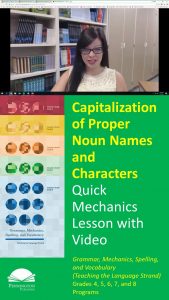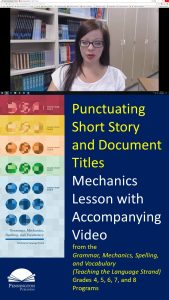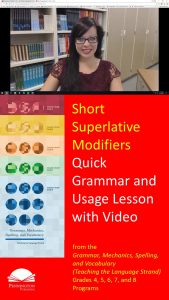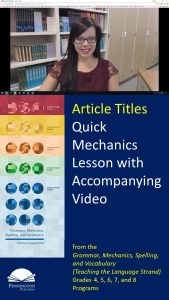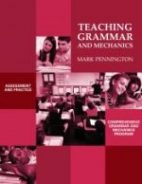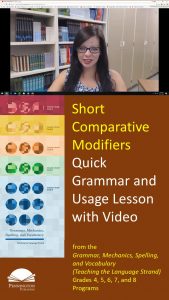Capitalization of Proper Noun Names and Characters
Capitalization of Proper Noun Names and Characters
Common Core Language Standard 2
Play the quick video lesson HERE and click the upper left back arrow to return to this lesson.
A proper noun can be simple, such as Donny, or complete, such as Mr. Donny Duck III. Now technically speaking, the words added to the simple proper noun are called proper adjectives, but we’re more interested in how to properly capitalize them in this lesson.
Today’s mechanics lesson is on capitalizing proper noun names and characters.
Now let’s read the mechanics lesson and study the examples.
Capitalize people’s and characters’ names. Also capitalize named places and things. Don’t capitalize articles, conjunctions, and prepositions in the middle of the name, named place, or named thing. Don’t capitalize words representing these parts of speech when found in the middle of people’s or character names.
- Articles (a, an, the) Example: Courage the Cowardly Dog
- Conjunctions Example: Punch and Judy
- Prepositions Example: St. Francis of Assisi
Now circle or highlight what is right and revise what is wrong according to mechanics lesson.
Practice: My dad was a Native-american and his favorite superhero was Batman.
Let’s check the Practice Answers.
Mechanics Practice Answers: My dad was a Native-American and his favorite superhero was Batman.
Now let’s apply what we have learned.
Writing Application: Write your own sentence using a character’s name including an article.
*****

Pennington Publishing Grammar Programs
Teaching Grammar, Usage, and Mechanics (Grades 4, 5, 6, 7, 8, and High School) are full-year, traditional, grade-level grammar, usage, and mechanics programs with plenty of remedial practice to help students catch up while they keep up with grade-level standards. Twice-per-week, 30-minute, no prep lessons in print or interactive Google slides with a fun secret agent theme. Simple sentence diagrams, mentor texts, video lessons, sentence dictations. Plenty of practice in the writing context. Includes biweekly tests and a final exam.
Grammar, Usage, and Mechanics Interactive Notebook (Grades 4‒8) is a full-year, no prep interactive notebook without all the mess. Twice-per-week, 30-minute, no prep grammar, usage, and mechanics lessons, formatted in Cornell Notes with cartoon response, writing application, 3D graphic organizers (easy cut and paste foldables), and great resource links. No need to create a teacher INB for student make-up work—it’s done for you! Plus, get remedial worksheets, biweekly tests, and a final exam.
Syntax in Reading and Writing is a function-based, sentence level syntax program, designed to build reading comprehension and increase writing sophistication. The 18 parts of speech, phrases, and clauses lessons are each leveled from basic (elementary) to advanced (middle and high school) and feature 5 lesson components (10–15 minutes each): 1. Learn It! 2. Identify It! 3. Explain It! (analysis of challenging sentences) 4. Revise It! (kernel sentences, sentence expansion, syntactic manipulation) 5. Create It! (Short writing application with the syntactic focus in different genre).
Get the Diagnostic Grammar, Usage, and Mechanics Assessments, Matrix, and Final Exam FREE Resource:
![]()
